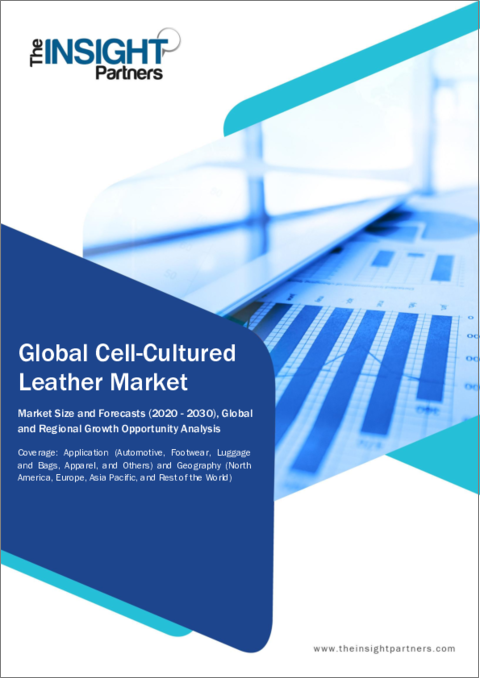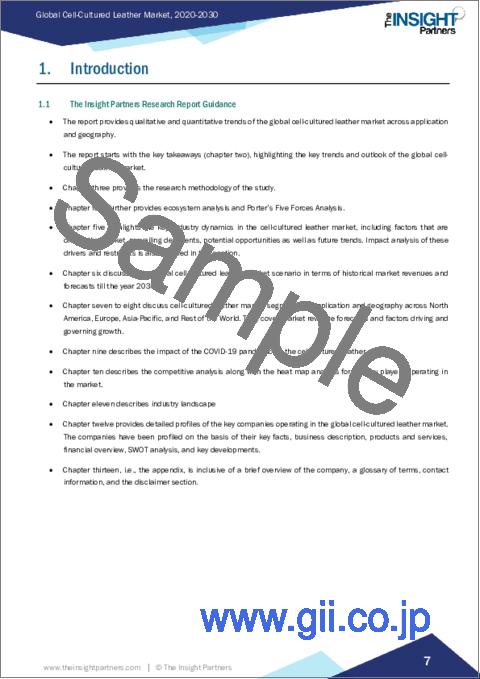|
|
市場調査レポート
商品コード
1389678
細胞培養レザーの市場規模・予測、世界・地域別シェア、動向、成長機会分析レポート対象範囲:用途別Cell-Cultured Leather Market Size and Forecasts (2020 - 2030), Global and Regional Share, Trends, and Growth Opportunity Analysis Report Coverage: By Application (Automotive, Footwear, Luggage and Bags, Apparel, and Others) |
||||||
|
|||||||
| 細胞培養レザーの市場規模・予測、世界・地域別シェア、動向、成長機会分析レポート対象範囲:用途別 |
|
出版日: 2023年10月30日
発行: The Insight Partners
ページ情報: 英文 43 Pages
納期: 即納可能
|
- 全表示
- 概要
- 図表
- 目次
細胞培養レザーの市場規模は、2022年には405万米ドルと評価され、2030年には815万米ドルに達すると予測され、2022年から2030年までのCAGRは9.1%と推定されます。
細胞培養レザーは、酵母細胞、バイオベースの足場、コラーゲン、バイオリアクターなど、さまざまな材料から作られています。細胞培養レザー市場のプレーヤーは、細胞培養レザーを作るために特許技術を使用しています。細胞培養レザーは、自動車、靴、バッグ、アパレル、その他の用途に応用されています。さらに、世界の細胞培養レザー市場は競争が激しいです。細胞培養レザー市場には新規参入障壁はほとんどないです。初期資本投資の必要性、既存プレーヤーとの高い競合、高い技術コストなどの参入障壁は、新規市場プレーヤーの参入決定に大きく影響します。さらに、市場における代替製品の利用可能性は、企業の市場での地位や製品提供を脅かす可能性があります。細胞培養レザーの代替製品は、伝統的な皮革、ポリウレタン、ポリ塩化ビニル、バイオベースの材料から作られた合成皮革、菌糸ベースの皮革、その他など数多くあります。したがって、細胞培養レザーの代替製品が利用可能かどうかは、市場成長に影響を与えます。
用途に基づき、世界の細胞培養レザー市場は自動車、フットウェア、鞄・バッグ、アパレル、その他に区分されます。アパレル分野の細胞培養レザー市場シェアは2022年に最大となることが記録されました。自動車は、細胞培養レザー市場の2番目の主要用途分野です。自動車産業では大量の化石燃料が消費され、気候変動に大きく寄与しています。しかし、近年、世界中の様々な自動車メーカーが、消費者の需要の増加と気候変動への関心の結果として、持続可能な代替品を自動車に提供し始めています。これらすべての要因が、自動車産業からの細胞培養レザーの需要を促進すると予想されます。
地域別に見ると、世界市場は北米、欧州、アジア太平洋地域、その他アジア太平洋地域に区分されます。2022年には、北米が世界最大の細胞培養レザー市場シェアを占めました。北米の細胞培養レザー市場の成長を促進する要因は、靴、鞄、バッグ、衣料品に対する需要の高まりと、持続可能な製品を使用することへの関心の高まりです。北米の様々な企業やブランドは、持続可能な製品に対する消費者の需要の高まりを受けて、持続可能な製品の開発に注力しています。さらに、伝統的な皮革製造工程に対する意識の高まりも、この地域の市場成長を後押ししています。従来の方法で革を得るためには、何頭もの家畜が屠殺されます。さらに、これらの家畜を飼育するには、土地や水の面で多くの資源を必要とします。牛の飼育は、毎年世界の温室効果ガス排出量のかなりの割合を占めています。皮革を生産するために動物の皮や皮革を処理するなめし工程もまた、非常に汚染性の高いものです。
細胞培養レザー市場に参入している主な企業は、VitroLabs Inc、MODERN MEADOW、Qoriumです。同市場を運営する企業は、様々な用途産業からの顧客需要を満たすために、高品質の製品を生産する研究開発活動に注力しています。例えば、VitroLabs Inc.は2022年に4,600万米ドルを調達し、世界初の細胞培養レザーのパイロット生産を構築し、規模を拡大しました。さらに2021年、Qoriumは細胞培養コラーゲンベースのレザー技術をスケールアップするための研究開発を拡大するために260万ユーロ(275万米ドル)を調達しました。さらに2023年には、Modern MeadowがシリーズD資金を調達しました。この資金調達はAstanor Ventures、Horizons Ventures、Key Partners Capitalが主導したもので、Modern Meadowがイノベーションを継続するための支援となります。
世界の細胞培養レザー市場全体の規模は、一次情報と二次情報の両方を用いて導き出されました。調査プロセスを開始するにあたり、市場に関する質的・量的情報を入手するため、社内外の情報源を用いて徹底的な二次調査を実施しました。また、データを検証し、このテーマについてより分析的な洞察を得るために、業界関係者に複数の一次インタビューを実施しました。このプロセスの参入企業には、副社長、事業開発マネージャー、マーケットインテリジェンスマネージャー、国内営業マネージャーなどの業界専門家と、細胞培養レザー市場を専門とする評価専門家、調査アナリスト、キーオピニオンリーダーなどの外部コンサルタントが含まれています。
目次
第1章 イントロダクション
第2章 エグゼクティブサマリー
- 主要洞察
- 市場の魅力
第3章 調査手法
- 調査範囲
- 2次調査
- 1次調査
第4章 細胞培養レザーの世界市場情勢
- エコシステム分析
- ポーターのファイブフォース分析
- 供給企業の交渉力
- 買い手の交渉力
- 新規参入業者の脅威
- 競争企業間の敵対関係の強さ
- 代替品の脅威
第5章 細胞培養レザーの世界市場:主要市場力学
- 市場促進要因
- 持続可能で無害な皮革に対する需要の高まり
- 市場抑制要因
- 代替製品の入手可能性
- 市場機会
- 進行中の研究開発活動
- 今後の動向
- 持続可能な製品開発に対するフットウェア・アパレル業界の注力
- 影響分析
第6章 細胞培養レザーの世界市場分析
- 細胞培養レザーの世界市場収益
- 細胞培養レザーの世界市場予測と分析
第7章 細胞培養レザーの世界市場分析:用途別
- 自動車
- フットウェア
- ラゲッジとバッグ
- アパレル
- その他
第8章 細胞培養レザーの世界市場:地域別分析
- 北米
- 欧州
- アジア太平洋
- 世界のその他の地域
第9章 COVID-19パンデミックの世界細胞培養レザー市場への影響
- COVID-19前後の影響
第10章 競合情勢
- 主要プレーヤー別ヒートマップ分析
- 企業のポジショニングと集中度
第11章 業界情勢
- 事業拡大
第12章 企業プロファイル
- VitroLabs Inc
- Modern Meadow Inc
- Qorium BV
第13章 企業概要付録
List Of Tables
- Table 1. Global Cell-Cultured Leather Market Segmentation
- Table 2. Global Cell-Cultured Leather Market Revenue and Forecasts To 2030 (US$ Thousand)
- Table 3. Global Cell-Cultured Leather Market Revenue and Forecasts To 2030 (US$ Thousand) - Application
List Of Figures
- Figure 1. Global Cell-Cultured Leather Market Segmentation, By Geography
- Figure 2. Ecosystem: Global Cell-Cultured Leather Market
- Figure 3. Global Cell Cultured Leather Market - Porter's Five Forces Analysis
- Figure 4. Global Cell-Cultured Leather Market Impact Analysis of Drivers and Restraints
- Figure 5. Global Cell-Cultured Leather Market Revenue (US$ Thousand), 2020 - 2030
- Figure 6. Global Cell-Cultured Leather Market Share (%) - Application, 2022 and 2030
- Figure 7. Automotive Market Revenue and Forecasts To 2030 (US$ Thousand)
- Figure 8. Footwear Market Revenue and Forecasts To 2030 (US$ Thousand)
- Figure 9. Luggage and Bags Market Revenue and Forecasts To 2030 (US$ Thousand)
- Figure 10. Apparel Market Revenue and Forecasts To 2030 (US$ Thousand)
- Figure 11. Others Market Revenue and Forecasts To 2030 (US$ Thousand)
- Figure 12. Global Cell-Cultured Leather Market Breakdown by Geography, 2022 and 2030 (%)
- Figure 13. North America Cell-Cultured Leather Market Revenue and Forecasts To 2030 (US$ Thousand)
- Figure 14. Europe Cell-Cultured Leather Market Revenue and Forecasts To 2030 (US$ Thousand)
- Figure 15. Asia Pacific Cell-Cultured Leather Market Revenue and Forecasts To 2030 (US$ Thousand)
- Figure 16. Rest of the World Cell-Cultured Leather Market Revenue and Forecasts To 2030 (US$ Thousand)
- Figure 17. Heat Map Analysis By Key Players
- Figure 18. Company Positioning & Concentration
The cell-cultured leather market size was valued at US$ 4.05 million in 2022 and is expected to reach US$ 8.15 million by 2030; it is estimated to register a CAGR of 9.1% from 2022 to 2030.
Cell-cultured leather is made from different materials, such as yeast cells, bio-based scaffolds, collagen, and bioreactors. The players in the cell-cultured leather market use their patented technology to make cell-cultured leather. Cell-cultured leather finds in application in automotive, footwear, luggage and bags, apparel, and other applications. Further, the global cell cultured leather market is highly competitive. There are few entry barriers in the cell cultured leather market for new entrants. Entry barriers such as the requirement of initial capital investments, high competition from existing players, and high technology costs significantly affect the entry decisions of new market players. Furthermore, the availability of substitute products in the market can threaten a company's market position and product offerings. There are many substitute products for cell cultured leather, such as traditional leather, synthetic leather made from polyurethane, polyvinyl chloride, and bio-based materials, mycelium-based leather, and others. Thus, the availability of substitute products for cell-cultured leather affects the market growth.
Based on application, the global cell-cultured leather market is segmented into automotive, footwear, luggage and bags, apparel, and others. The cell-cultured leather market share for the apparel segment was recorded to be the largest in 2022. Automotive is second major application segment of the cell-cultured leather market. A large amount of fossil fuel is consumed by the automotive industry, which contributes massively to climate change. But, in recent years, various automotive manufacturers across the globe have begun to offer sustainable alternatives in their vehicles as a result of increased consumer demand and attention to climate change. All these factors are expected to drive the demand for cell-cultured leather from the automotive industry.
Based on geography, the global market is segmented into regions such as North America, Europe, Asia Pacific, and the Rest of the World. In 2022, North America held the largest global cell-cultured leather market share. The factors driving the cell-cultured leather market growth in North America are the rising demand for footwear, luggage, and bags, as well as clothing products, and a growing focus on using sustainable products. Different companies and brands from North America are focusing on developing sustainable products in response to the rising consumer demand for sustainable products. In addition, the rising awareness about the traditional leather manufacturing process is also fueling the market growth in the region. Several livestock animals are slaughtered in order to obtain leather through conventional methods. Moreover, raising these animals requires a lot of resources in terms of land and water. Cattle rearing is responsible for a significant percentage of global greenhouse gas emissions every year. The tanning process is also highly polluting, in which animal skins and hides are treated to produce leather.
A few key players operating in the cell-cultured leather market are VitroLabs Inc, MODERN MEADOW, and Qorium. Players operating in the market focus on research and development activities to produce high-quality products to fulfill customer demand from various application industries. For instance, In 2022, VitroLabs Inc raised US$ 46 million to build and scale the world's first pilot production of cell-cultivated leather. Moreover, In 2021, Qorium raised € 2.6 million (US$ 2.75 million) to expand research and development to scale up its cell-cultured collagen-based leather technology. In addition, in 2023, Modern Meadow raised Series D funding. The funding is led by Astanor Ventures, Horizons Ventures, and Key Partners Capital, which will support Modern Meadow to continue its innovation.
The overall global cell-cultured leather market size has been derived using both primary and secondary sources. To begin the research process, exhaustive secondary research has been conducted using internal and external sources to obtain qualitative and quantitative information related to the market. Also, multiple primary interviews have been conducted with industry participants to validate the data and gain more analytical insights into the topic. The participants of this process include industry experts such as VPs, business development managers, market intelligence managers, and national sales managers-along with external consultants such as valuation experts, research analysts, and key opinion leaders-specializing in the cell-cultured leather market.
Reasons to Buy:
- Highlights key business priorities in order to assist companies to realign their business strategies.
- The key findings and recommendations highlight crucial progressive industry trends in the global cell-cultured leather market, thereby allowing players to develop effective long-term strategies.
- Develop/modify business expansion plans by using substantial growth offering developed and emerging markets.
- Scrutinize in-depth the market trends and outlook coupled with the factors driving the market, as well as those hindering it.
- Enhance the decision-making process by understanding the strategies that underpin commercial interest with respect to products, segmentation, and industry verticals.
Table Of Contents
1. Introduction
- 1.1 The Insight Partners Research Report Guidance
- 1.2 Market Segmentation
2. Executive Summary
- 2.1 Key Insights
- 2.2 Market Attractiveness
3. Research Methodology
- 3.1 Coverage
- 3.2 Secondary Research
- 3.3 Primary Research
4. Global Cell-Cultured Leather Market Landscape
- 4.1 Overview
- 4.2 Ecosystem Analysis
- 4.3 Porters Five Forces Analysis
- 4.3.1 Bargaining Power of Suppliers
- 4.3.2 Bargaining Power of Buyers
- 4.3.3 Threat of New Entrants
- 4.3.4 Intensity of Competitive Rivalry
- 4.3.5 Threat of Substitutes
5. Global Cell-Cultured Leather Market - Key Market Dynamics
- 5.1 Market Drivers
- 5.1.1 Rising Demand for Sustainable and Cruelty-Free Leather
- 5.2 Market Restraints
- 5.2.1 Availability of Substitute Products
- 5.3 Market Opportunities
- 5.3.1 Ongoing Research and Development Activities
- 5.4 Future Trends
- 5.4.1 Focus of Footwear and Apparel Industries on Developing Sustainable Products
- 5.5 Impact Analysis
6. Cell-Cultured Leather Market - Global Market Analysis
- 6.1 Global Cell-Cultured Leather Market Revenue (US$ Thousand)
- 6.2 Global Cell-Cultured Leather Market Forecast and Analysis
7. Global Cell-Cultured Leather Market Analysis - Application
- 7.1 Automotive
- 7.1.1 Overview
- 7.2 Footwear
- 7.2.1 Overview
- 7.3 Luggage and Bags
- 7.3.1 Overview
- 7.4 Apparel
- 7.4.1 Overview
- 7.5 Others
- 7.5.1 Overview
8. Global Cell-Cultured Leather Market - Geographical Analysis
- 8.1 North America
- 8.1.1 North America Cell-Cultured Leather Market Revenue and Forecasts to 2030 (US$ Thousand)
- 8.2 Europe
- 8.2.1 Europe Cell-Cultured Leather Market Revenue and Forecasts to 2030 (US$ Thousand)
- 8.3 Asia Pacific
- 8.3.1 Asia Pacific Cell-Cultured Leather Market Revenue and Forecasts To 2030 (US$ Thousand)
- 8.4 Rest of the World
- 8.4.1 Rest of the World Cell-Cultured Leather Market Revenue and Forecasts to 2030 (US$ Thousand)
9. Impact of COVID-19 Pandemic on Global Cell-Cultured Leather Market
- 9.1 Pre & Post Covid-19 Impact
10. Competitive Landscape
- 10.1 Heat Map Analysis By Key Players
- 10.2 Company Positioning & Concentration
11. Industry Landscape
- 11.1 Overview
- 11.2 Expansion
12. Company Profiles
- 12.1 VitroLabs Inc
- 12.1.1 Key Facts
- 12.1.2 Business Description
- 12.1.3 Products and Services
- 12.1.4 Financial Overview
- 12.1.5 SWOT Analysis
- 12.1.6 Key Developments
- 12.2 Modern Meadow Inc
- 12.2.1 Key Facts
- 12.2.2 Business Description
- 12.2.3 Products and Services
- 12.2.4 Financial Overview
- 12.2.5 SWOT Analysis
- 12.2.6 Key Developments
- 12.3 Qorium BV
- 12.3.1 Key Facts
- 12.3.2 Business Description
- 12.3.3 Products and Services
- 12.3.4 Financial Overview
- 12.3.5 SWOT Analysis
- 12.3.6 Key Developments






